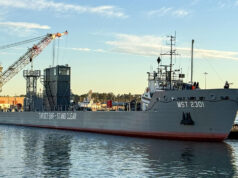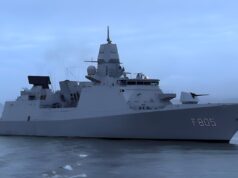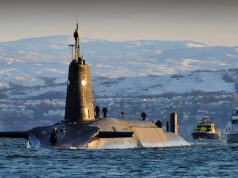In response to a series of written parliamentary questions from Conservative MP James Cartlidge, the UK government has reiterated its commitment to achieving 2.5% of GDP expenditure on defence.
This comes despite recent remarks from the armed forces minister, Luke Pollard, indicating that increased military spending is contingent on economic growth.
Cartlidge’s questions covered a wide range of defence priorities, including the Land Environment Tactical Communications and Information Systems programme, upgrades to the existing fleet of Typhoon fighter jets, and the development of the Challenger 3 Main Battle Tank. Each query received a consistent response from Minister of State for Defence, Maria Eagle.
“The Government is fully committed to spending 2.5% of GDP on defence as soon as possible. The Government will set out a clear path to 2.5% at a future fiscal event,” stated Eagle in her responses.
She also mentioned the government’s aim to deliver a defence programme that is both affordable and capable of countering the diverse threats facing Britain in the 21st century.
This commitment is framed within the broader context of recent comments by Luke Pollard, who highlighted the dependency of increased defence spending on economic growth.
Speaking on BBC Radio 4’s Today programme, Pollard stated, “The way we deliver increased public spending on defence, on schools, hospitals or prisons, is by growing our economy. If we don’t grow our economy, there won’t be the money to support those public services and the ambitions that we have – and that includes defence.”
Cartlidge’s questions also touched on the impact of the defence spending timetable on various other projects, including the replenishment of munitions stockpiles, the delivery of the Shadow Mk1 fleet, and the procurement of a new mobile fires platform. In each case, Eagle reiterated the government’s commitment to the 2.5% GDP target, ensuring that the defence programme remains aligned with the nation’s strategic needs and economic capabilities.
The Labour government’s stance on defence spending contrasts with the previous Conservative government’s promise to achieve the 2.5% target by 2030. While Prime Minister Keir Starmer has expressed a “cast-iron” commitment to the 2.5% target, he has yet to provide a specific timetable for reaching this goal. Starmer’s approach underscores a cautious balancing act between national security priorities and economic growth.
As the UK prepares for a strategic defence review, the government faces the challenge of aligning its defence spending ambitions with economic realities. The outcome of this review is expected to be reported next year.














“Deliver a defence programme that is both affordable and capable of countering the diverse threats facing Britain in the 21st century”.
Interesting thing to say, without 2.5% on defence, their pans aren’t affordable.
Building mass into all three armed forces, starting GCAP and AUKUS, all simultaneously, on 2% is simply not affordable..
Except we were embroiled in two wars and NATO had enacted article 5 for the only time in its history but yeah the world was peaceful 😀
Don’t forget most of the equipment & upgrades procured for Herrick & Telic were done under UOR. That was all extra Treasury money outside of the 2.5% envelope. The envelope that didn’t include CASD as the time.
Returning to 2.5% is desperately needed. But as a bare minimum requirement. It should not be lauded as some glorious ambition.
2.5% will just about deliver existing programs and allow a modest restocking of munitions and updates to the Defence Estate. Assuming budgets don’t overrun on big projects. (Read Dreadnought and Tempest).
I think we’ll be back to square 1 by the end of the decade with 2.5% being materially insufficient.
Servicing the pension requirements alone are increasing year on year, and are only going to continue to get worse for some decades.
Things were always better “back in my day”
Peaceful? I had already done two tours in Afghanistan and one invasion of Iraq by that date Jim!
No worries. Its a fault with the forum thst you cannot reply to a specific poster.
The biggest stop or contraction for economic growth would be a war, therefore if you want growth increase defence spending as a deterrent to prevent it. I believe pollard said this himself, that war would make a programs like GCAP unaffordable due to the contraction in global economy. So they seem to know the impact just taking them awhile for the penny to drop on the solution 😀. I’ll give them time, its politicians we’re talking about after all.
Indeed, I suspect they know very well they need to move swiftly to 2.5% but the present Labour leadership are always looking to avoid the..”your profligate”attack line that will inevitably come out from the right and the “should spend it on poverty reduction not warmongering” from the left..sucks to be a social democrat.
I think it’s more targeted spin tbh. The direction was set pre election. Look at the announcement on Germany, why do this pre defence review not make sense if the defense review finds Germany has very little to offer the findings of the review. But we know Healey had coauthored a paper pre election on German cooperation so.it was going to happen irrespective of the reviews findings.
The review itself won’t be completely independent the government will have provided input parameters like jobs Europe, pay and conditions, NATO test , leave CASD and AUKUS out, don’ttouch it. It’s a tool.to justify why the will do things, some of which are decided pre review.
I disagree. Wars are usually good for GDP, because of the forced increase in government spending. They are particularly good for GDP per head (because fewer heads). But they are of course bad for the standard of living, because resources have to be shifted from personal consumption into defence spending – and this is achieved by raising taxation.
Erm big assumption is that your not on the loosing side, secondly if you lucky enough like the US to be a maon supplier whilst not having the domestic disruption of bombs actually falling on your infrastructure. Also economies are far more interlinked globally so parts will cease to function properly in a global conflict. Take financial sector it would collapse.
That’s great news, now let’s see the money and hardware.
There is just one simple truth that controls everything that any Government can do. Money and to get 2.5% GDP can only come at the expense of either cuts elsewhere or Taxes.
I suspect everyone who posts on here wants more £££ for defence, but it’s the only Budget Target that is expressed as a % of GDP.
I’m like most folks on here a bit of a Political Sceptic, but so far Starmer has stuck to his guns as demonstrated this week by suspending 7 MPs.
Previously Sunak had committed to 2.5% by 2030 but when you looked at how it was to be funded it was fanciful to say the least. IMHO it was just a pre election bribe and they had their fingers crossed.
If we can get growth going to say 2%+ then things start to get more affordable, what’s more Labour seem far keener on the UK Defence industry and understand investment in that has a multiplier effect.
So Jury is out let’s see what happens.
That isn’t that hard when you have got some growth.
UK does gave about 1.5% growth so using a relatively small part of that does the job.
That is a 0.3% up uplift over six years which is a not very impressive ramp rate of 0.05% per annum of GDP which is a rounding error in Treasury calculations.
I think you’ve got it there. Its not that hard. The economy took a long time to start recovering from Covid, probably because of the Brexit hit, but there is some growth in the economy now. Labour seem to be moving fast on the planning reforms and are making some clever moves on their GB renewable energy so I would expect private sector money to flow into the country and growth rate to increase. Next event will be Reeves’ revamp of the taxation system in the autumn budget. One paper mentioned her raising £25billion by taxing various types of unearned income.
Taxing the ‘unearned’ looks very tempting.
But at that point don’t expect pensioners to be very happy.
That will include a lot of public sector retirees on pensions that are unbelievable in todays terms.
And do expect a lot of money to move out of the country following the enormous amount to that left when non-doms sunset by Hunt.
Unfortunately we need very rich people to live and spend profligately in UKPLC .
Ye, the top rate tax allowance on pension contributions would be a possible target. Apparently Ms Reeves is off to the US in August on a charm offensive to attract US investment into the UK, which apparently has fallen by 42%. She is targeting Wall St looking for $10’s of billions. Private dinners with heads of property investment companies etc. I don’t think she is depending on wealthy UK tax payers and conservative party donors to make the economy grow. I also expect the govt to get the UK pension funds to invest in GB energy and infrastructure initiatives. I can see UK weapons manufacture being favoured e.g Merlins for NMH, more Typhoons, more Boxers.
With that recipe the pension destruction started by Gordon Brown would be complete.
BTW no US companies will invest unless the sums add up.
So you either need huge tax breaks for them or a genuine competitive advantage which isn’t just the usual UK Gig of fleecing a captive market…
Regarding the pensions industry you could take the cynical view; use it or lose it. I did see that the govt are enabling consolidation of pensions which will increase the value of your pension. Don’t know what her sales pitch is, but wish her well. Lots of schools, hospitals, pylons, rail tracks, power plants need building. Point taken on captive market….welcome to ripoff UK.
I wish her well for the sake of UKPLC.
Hunt wasn’t charismatic or imaginative but he did start moving the dials in the right direction.
I can tell you as an owner of multiple SMEs that two majors sectors of the economy are on their knees and will take years to recover.
If she tries anything around increasing taxes the number of business insolvencies will be unreal – it is very bad out there. Good businesses can’t get credit.
What UKPLC urgently needs is reasons to invest and investment funds. There is a reason the funding dried up UKPLC is a nightmare place to invest with massive regulation and an out of control HSE making things very expensive and difficult to do.
There is also another problem of the black economy undercutting the legitimate economy in a lot of sectors.
Important to hear from the SME ‘coal face’. More power to your elbow. The country is dysfunctional on many levels. Is any other country flagellating itself with mega inquiries over how it handled covid? Or screws its post masters? Or knowingly infects its own children with infected blood? Why do we have a tax system which incentivises creating wealth through ‘rent seeking’ behaviour and short term shareholder gain rather than rolling up your sleeves and working for longterm growth and profitability?
Answers on a post card. Best wishes with your businesses.
The core issue is actually breaking feedback loops because it is claimed to be efficirnt.
Justice 900 odd (decent postmasters) are given criminal convictions because PO I has decided a criminal conspiracy to pervert the course of justice is the solution to not fixing its computer system.
The problem, however, is the
900 incompetent stupid useless prosecution barristers
900 incompetent stupid useless prosecution barristers and solicitors at Wombles and other places (so did more than one prosecution so just square it each time)
900 incompetent stupid useless judges and court clerks
900 incompetent stupid useless defence barristers and solicitors.
Why the strong language? The expert witness statement around which most of this is based, that if Gareth Jenkins is no such thing.
Not because it was useless and biased – which it was.
BUT because it lacked the opening and closing statement that are required both in criminal and civil proceeding.
Yup, that is right. None of the above cast of goons threw this rubbish evidence out because it design nerf the basic rules.
The two times that judges demanded independent expert evidence PO dropped the cases.
Then we move onto the use of Sizing me Justice Procedure Prosecute 10’s thousands of people who didn’t pay, often innocently, rail fares.
Only problem was SJP doesn’t cover the railways acts.
So the dozy judges were rubber stamping this illegal demands made by the rail companies.
Will the people who falsely prosecuted these people be arrested – doubt it. So carry on abusing g the legal system.
MoJ do’t care as the bulk uploads system generated £££££££ not justice.
If you can’t see how this level of incompetence extends into the utterly bent parking tickets and debt collection baliff industries you have to be pretty stupid.
They know the system doesn’t work and there is no comeback and no checks and balances.
When we are running at 2.5% ….. increases in budgets needs to be done in bite size chunks otherwise people freak out.
In what context would they freak out?
Because they don’t see why 2.5 % should be spent due to the list of priorities?
or because
if it went to 3% immediately they would take that as tantamount to being told war is imminent?
Either way I disagree.
As the primary responsibility for any government is the protection of the people,
If they explain the reasons why in a concise & unambiguous manner then I fail to see why people woudl freak out.
Surely if they don’t do it “because they don’t want to scare them” thats even worse?
“The FIRST duty of any government is to keep the country safe” Labour manifesto June 2024 (my capitals).
So, logically and sadly, welfare, NHS, social services have to come second. However much it hurts. Savings CAN be made when needs must.
Agree first way to cut £5-6 billion off the NHS budget whilst improving frontline care would be to have a bonfire of quangos, useless tier after tier of managers and stop the BS that is the internalised market of the National health service. Just go back to budget from central government goes direct to NHS trusts to commission set services and provisions.
No need for CCGs, PCTs, GP fund holders etc. get rid of the lot. Job done £20 billion a year saved. £14 billion goes back to the NHS for frontline care then 5-6 billion for defence or infrastructure to grow the economy. Just takes guts to admit too much rot and BS has set in.
Then repeat for social services, education etc and reap the rewards for British taxpayers.
You do realise we spend less than almost any other OECD country on health care right?
But you’re convinced you can find 10% efficiency savings by removing management.
That is impressive. What multi national organisation do you currently run 😀
Unlike your demeaning post my post was factually accurate and correct. I set out clear evidence of how the NHS could easily save huge sums of money just by going back to what we had in the 1990s in terms of commissioning- eg direct from Whitehall and NHS England/Scotland and Wales direct to trusts and providers- removing CCGs, PCTs and GP fund holders and simply reverting back to a frontline focussed bang for bucks process of delivering services and care.
That’s not running a big multi-national organisation that is just common sense and despite the “neigh sayers” is within our gift to deliver. Just takes political will and determination- I think if the general public were told we are going to get rid of CCG, PCTs and GP fund holding and pump an extra £14 billion into the NHS frontline ensuring you can see a GP quickly, your operation is performed within a reasonable timeframe and you wont have to wait days and days in A+E then they would be supportive of that.
Whilst I get the thrust of your argument and there has been much critism of the existing system that does not automatically mean that reverting to the previous strategy is the best way forward. The NHS works well on many levels but it also has problems on many levels and some of them cannot be fixed simply by money or sacking people.
The NHS needs a truly inspirational leader who can set it on the right path. The NHS needs to also take on elderly care properly. Also we need to make some serious headway in curing cancer & dementia. We are overdue a miracle cure – the last one was antibiotics I think.
I think it is fine for the politicians & the public to state what they want from their NHS, the objectives, but once we start interfering in how it is run we are all f**ked.
Nonsense. Just because quangos are quietly getting on with their roles (quite sucessfully in the main) doesn’t mean they are not doing important stuff best not overseen by a politican.
Who is threatening the UK then? I must have missed that one.
To be fair there is only one possible candidate in Europe. In the late 1930s you could have argued that Nazi Germany was not threatening the UK – yet we all know it was really and all we could do was prepare for a likely conflict. Now we need to build our forces to deter but also to aid the fight should we fail to deter.
Agree to a point. The problem with defence is it works backwards. It is a deterrance. The kit we buy has only served it’s purpose if we never have to use it in anger. Whereas if we don’t buy kit for maternity wards we get dead babies (and mothers for that matter). If we had an efficient NHS, oddly, it would probably cost less and be better. Getting people to take up that poisoned chalace is a problem.
Neither. Yes MPs have a list of priorities and very few of them were banging on about defence on the doorstep – especially Labour. Many of the MPs first arrived in parliament when they had a leader who was not interested in a strong defence – quite the reverse.
Most would come to their senses if actually at war.
The issue is that it is far easier to sell a strategy which is only likely to have a minor impact on day one. Then a little more impact after a year etc. Eventually before you know it you are at 2.5-3.0%.
Grizzler. There are few people alive today who remember a major war in Europe which affects them. People are complacent and in denial. They have absolutely no idea what is at risk and they do not wish to know. They expect their Government to sort that out and provide a working NHS and provide them benefits if they are out of work etc. etc.
mmm not sure I agree with that – if Russia alone was taken on by the full and complete collective of Europe (inc. Finland, Sweden . & perhaps Turkey) I think they would lose.
Don’t forget at that juncture Russia itself would be party to attack -which is not happening now with the Ukraine conflict.
Although of course if America also pulled the plug on all sales of its armaments to Europe then yes that could be somewhat of a different consideration
The production of ammo in Europe exceed the one of USA. For aerial bomb, it will soon match USA. For missiles, getting close. We will outpace Russia soon.
Come off it! Yes Europe and the UK should be beefing up their defences. But Russia can’t defeat Ukraine never mind the rest of Europe combined!
Geographical Ukraine’s is in Europe, your comment was the second largest economy in the world can’t defend itself suggesting the EU is at war.
Exactly, 2.5% of GDP, followed by 3.0% (or 2.75% as an interim measure, if there is resistance to a single half percent increase). Emphasis on not shocking HMG Treasury into a catatonic state. 🤔😳😉
The problem is that there is a 5% of GDP hole that needs backfilling in defence lack of investment.
yes correct- capex is in particular is poorly underfunded.
Understood, however politics is sometimes defined as the art of the possible. Unfortunately, almost inconceivable that 5% of UK GDP would be allocated to defence, short of declared war. At that juncture, any increase in funding would be a largely futile gesture, given the lead times for modern weapon systems manufacturing. Almost a 21st century version of “Catch-22.” 🤔😳😱☹️
The catch up gap is 5% of GDP.
Plus whatever level is needed.
The back of my fag packet actually indicates that 2.75% GDP is required on a continuum to
Have an RN of
2 x QEC
12 x T26
6 x T45
8 x T31
8 x T32
12 x SSN
4 x SSBN
6 Albion/Bay/Argus
5 fleet tankers
3 Solids support
4 Mine mother ships fully kitted out
Rivers (I don’t like them but we need a few)
Realistic availability of 24 F35B routinely
Extension if Merlin
Heavy lift drone(s)
AAR drones for QEC
ASW heavy drones filing and torpedo carrying for augmenting classes
QEC launch able heavy drone for RM support FIRES
PODS CAMM systems
A further buy of NSM for the RM ships to provide fast fires support while they are establishing.
RAF
200+ front line fighter/bombers in full service with enough pilots for tempo to allow RN to detach 24 F35B without stripping the cupboard
12 P8
6 E7
60 Chinook
12 x C130 (yup you read that right)
8 more A400M
A new trainer type
Army
I don’t know a lot as that was never my thing.
50 Apache
CH3 all hulls converted
M270 all system upgraded
Ah, finally understand your CAPEX point. Germany created a one time fund, presume you Brits could replicate the concept. Nonetheless…that’s one helluva Christmas wish list, guaranteed to cause consternation for St. Nicholas’ Elves at Treasury to fulfill! 😁 Of course, always the best course to start high in a negotiation. 👍 Four additional T-26? Certainly feasible, if BAES is cooperative re pricing. Twelve SSN-A? Perhaps, if the dominoes all fall correctly. Notice the number of GCAP/Tempest not specified in RAF fleet. Wise hedging. Am quite concerned 6th gen pricing will be an unpleasant surprise for all. 🤔😳😱
“ Notice the number of GCAP/Tempest not specified in RAF fleet. Wise hedging. Am quite concerned 6th gen pricing will be an unpleasant surprise for all.”
A hi-lo mix as per T26/T31 would allow for that? I know RAF us super Gucci but at some point mass does have to be taken into account?
“ presume you Brits could replicate the concept”
Hell would freeze over first bit the RE-CAPEX / CAPEX / OPEX budgets do need to be more clearly separates to prevent fudgy fixing of The Black Hole…..which swallows up all progress!
Hi/Lo mix is probably the only feasible course for future RN surface escort and RAF fast jet fleets. Even Uncle Sugar is gulping over estimates for future USAF fleets.
Not certain re your final point. How would substantive rearmament proceed in a timely manner, absent a ring fenced CAPEX fund? 🤔
It absolutely should be ring fenced.
But we are not in a country where the pork barrel leads to legislated links between money and kit.
So how to keep it away from…….
Huh, I obviously do not comprehend the intracasies/idiosyncrasies of MoD budgets. As a general rule, Congress specifies, by line item, where funds will be expended. Woe betide the shlub who chooses to freelance, w/out at least tacit approval of the paymasters.
Nothing like that here.
The legislature cities on the overall budget that never contains that level of detail so there are few constraints on moving money from one pot to another.
Hmmm…certainly a conundrum. Ideally, it would be very beneficial if a PM w/ military experience and strategic vision happened to be waiting in the wings, ala W. S. Churchill circa 1940. Absent that, another Defence Minister in the mold of Big Ben should prove to be helpful, although even he was not able to secure sufficient funds for the MoD in internecine budget negotiations. Bureaucratic budget inertia is a powerful force, and typically responds to changes in course as nimbly as the average supertanker. 🤔😳😵
ring fenced- 100%!👌
You would see Treasury and MoD mandarins having seizures with that concept!
I could write a whole new Yes, Minister script on that…….
looking forward to viewing the script if you land a production deal😉
That plan actually sounds like a good return on investment -all of those assets for 2.75% for gdp. It refreshing to see some cost analysis as opposed to most of us dropping in a fantasy wish list. I imagine your calculations are factored on the government actually scaling up now and getting on with it?.
My frustration is the ongoing deferment – all this talk of 2,5% by 2023 is simply far to little to late – now is the time.
It is all pretty realistic.
Most of it isn’t far off what services are currently in line for or is in the general equipment plan.
The RAF 200+ front line is existing Typhoon (130 ish) + F35B (74 ish) so no madness there.
Where I went a bit rogue was where I suggested a number of F35B should be RN detachable on a pretty much permanent basis.
But one you take account of OCU etc the fleet numbers increase isn’t so crazy as a percentage.
cheers SB -good work Mate.
Yes well we will need to prioritise and also push cheaper weapons systems which our enemies will have anyway.
Yes, why I’m a fan of CAMM and its relatives.
Going all Gucci because we can only afford the minimum numbers leads to some crazy purchasing where R&D us far for than the purchased #….
Indeed. Also politicians get in a flap if the money they had hoped would go to their pet project gets diverted to buying missiles or something. Best to just tell them they will start the project it will just be delayed a bit.
Huh, substantially different Budget ROEs between UK and US. Previously unaware of differences. 🤔😳
There is a power struggle going on inside the Labour party. The leader is attempting to excise a left wing minority group which are in effect suggesting we don’t need spending on defence and siimply should rely on deplomacy alone. The Labour party know that in order to be taken seriously in years to come they must be seen as serious & modern.
Ah, yes. The US is similarly burdened w/ the “Progressive Wing” of the Democratic Party. There will always be the 3-sigma cases. 🙄
The increasing threats to World peace may require special fiscal measures in either a one off tax harvest on 40% and above tax payers to fund a boost to bring forward key projects and help pay for additional manning of the RN and Army. War bonds could also be an option in place of extraordinary tax and offer an attractive ongoing investment? Whichever way the government approaches this thorny issue of ‘defence of the realm’ and unlike past governments, Labour has few options but to boost spending on the UK’s forces even before addressing NHS budgets.
Throwing money at the NHS has not proved very effective. In the 1960s it was about 1% of GDP now it is about 8%. It needs to be run properly.
Doubling the number of type 26s and type 31s on order would cost the UK Government next to nothing today as they would not be delivered for some time.
Peace bonds might send a better & less alarmist message however I think that the UK today has better methods of raising cash. Also increasing the tax rates would be an immediate pledge break and is probably not going to happen.
Oddly you didn’t mention how you are going to increase the size of the military?
The public are supportive of defence spending bring increased.
Problem is the country is broke.
Labour can’t promise money we don’t have.
The Tory’s were lying about increasing defence spending.
The country is certainly not broke. The country simply needs to prioritise growth first and foremost. When the economy grows the tax take increases and the amount spent on the NHS and Defence automatically increases. Because
GDP has increased then the GDP% stays the same but there is more money in the pot and more work to be done meaning more jobs etc.
On the other hand if the Government increase public sector pay for the same amount of work then that is more likely to fuel inflation which increases the cost of everything for the same amount of work. Rachel knows this but will need to control the Labour MPs if they are to grow the economy and increase defence spending and whilst they are at it grows spending for other departments,
The Torys had increased spending leading up to the election in a whole range of areas including defence however they knew the economy needed to grow in the next parliament. What Rishi failed to do was outline a plan to revive the NHS etc.
When was Europe asked to defend itself. I must have missed that war. Do you have any dates.
Freaking out achieves nothing. Also the Gvernment which rips billions in funding from the NHS etc. to give to defence when we are not even at war won’t be the Government for much longer.
Like Labour bragging about 2.5% GDP , and in fairness so we’re the Tory party .But really it should be at least 3% ,take a look at Poland 4% 🙄 🇬🇧 oh dear
Realistically, it needs to be 4% to allow one-off investments in infrastructure. We need to be able to, for example, produce ammunition with the ability to increase production quickly. That means having a lot of slack in the system – something that has been frowned on in the past.
To be honest the % GDP is a load of old horse shite..you should decide what you need to defend your interests and then fund for that…if that’s 2% because your economy is a burning hot cauldron of wealth creation or 4% because is a stagnant pool of mud, the required capability and the actual cost of that is all that really matters…
A percentage of GDP number is merely a convenient placeholder summarizing a detailed budget process. Presume no serious individual believes in managing to a periodically fluctuating number.
But our politicians do..they actually put 2.5% in the political manifestos we all just voted on in the UK….
The Treasury hates hypothecation…..the MOD budgets are not linked to GDP so they don’t fluctuate in that manner.
😳👍
pretty much – yep!
Can’t do it. There are no boundaries to what you ‘need’. You need to be able to assess things that are affordable – otherwise, why not 10%, 20% of GDP? There has to be a known cut off point – you can’t afford everything.
Hi Rob, no that’s not true, there is a difference between what you need and what you want…you simply must pay for what you need, if you don’t “something nasty this way comes”..if you know a war is likely if you don’t prepare to defend yourself, then your finances will not matter…if you don’t spend what is needed on Critical requirements..you pay big in blood and treasure.
As An example we spend around 410billion on the covid responce..NewZealand spent 26 billion..which if you balance for a population up to the UKs would equate to around 300billion…the difference was that NewZealand had not gutted its public health functions and was able manage and control outbreaks with only a 4 week full lockdown..we on the otherhand simply had no option other than 3 very long lockdowns or let it run and collapse the NHS….not paying what we needed for a functioning critical public health system cost us an extra 100billion in spending, a brutal set of lockdowns and a serious economic hit. Basically from 2011 we stopped paying for proper bio security and we got utterly hammered….for the sake of not providing adequate public health grants ( 4 billion a year vs the 2.4 billion we spent) we lost a fortune, many more died than needed, children lost a year’s education and all had to stay at home for a long time.
We don’t choose to not pay the mortgage or eat…we pay the mortgage and for food until we no longer have money left…we do stop buying things we don’t need, but like…defence is the government version of food in your belly and a roof over your head….if we end up at war with a china/Russia powerblock we will not have an economy worth spit for a decade or more…that does not mean we build a new BAOR..but it does mean that we need to follow what the defence review say we need.
You will note I didn’t say need, I said ‘need’… One person’s wants are another person’s needs – and if there are no financial constraints ‘needs’ takes over from needs. Basically bloatware.
Hi Rob, no if you actually truly define the “need” that is not an issue..what you are describing is a system where people define “wants” as “needs”..if you have a mature system of discourse and robust needs assessment that’s not an issue..if you have an immature system where negotiations are based on wants..then you have an issue…one of the most interesting realities is that if you place significant false restrictions on a system( imposed financial constraints that in no way match what needs to be delivered) ..it tends to revert to that Immature system that negotiates on wants as needs..if on the other hand you develop a trusted system that identifies what it “needs” it works better….in reality most of the issues of inefficiency, waste and poor delivery we have in the public sector are driven by this low trust restricted system..take it from me this nation pisses away billions over time to save a few hundred thousands on in year budgets.
OK, Example. One person thinks the main concern is the submarine threat so considers more ASW assets to be a need. Another person says ‘no, the threat comes from enemy aircraft. We need more AA systems.’ Both agree that they ‘want’ both, but neither agree that they ‘need’ both. In reality, you aren’t ever going to cut out waste, it’s endemic. In some cases this is because the threat changes and you’ve ‘wasted’ a fortune on the ‘old’ threat… Think it’s time to agree to disagree?
Let me just give you an example the UK health system vs the french and German systems..
The UK system is essentially a cash restricted system, we don’t pay on need we pay on what the government is willing to give…this has essentially lead to a very cheap but profoundly ineffective system..as we let people get sicker before we treat them and down stream care is probably 10 times more inefficient that upstream care…in the end we screw ourself in poor health and bad outcomes that in the end have vast financial impact.
The German ( and french) system is not cash restricted, it’s the German system itself that decided how much money it gets and spends..leading to a system that is highly effective and delivers good outcomes..yes it’s more costly as it gets paid the correct amount to deliver against need..but it does not collapse and cost the nation in th long run on poor health and the ecconomic drag of a sick population…
Thats the thing I’ve studying and compared health systems that work on good need assessment and are not based around cash restrictions..and they are simply better at delivering and in the long term they work better…
Your argument of people how people arguing the toss over need is what happens in the UK NHS as it’s profoundly cash restricted.
I would honestly suggest looking at how Germany decides its health service budget…it’s very very interesting and shows that when you trust a system you get an adult response that is not…”well my ASW is the only thing that matters”.
Agree Jonathan. Various commentators and defence specialist state that we should throw out the % argument and simply ask ourselves what do we need to ensure the defence of our national interest and defence of the realm and then give the armed forces that capability.
When you answer that it looks very very much different to our current anaemic forces structure and numbers.
Something like 50,000 personnel for RN and RAF and an army around 100,000 troops.
Labour have a mess to sort out that’s for sure, our armed forces have never been in such a perilous state as now.
that is a very good observation Jonathan.
Healey says the armed forces are in a “far worse state than we thought” and Reeves makes similar noises about government finances. OBR forecasts are detailed and generally reliable, and the state of the armed forces( and the funding of them) has been regularly revealed in great detail. So they were fully informed about both or should have been. In the same speech, Healey refers to decades of under investment leading to the hollowing out of forces. Indeed, the decline goes back 30 years for nearly half of which Labour were in power. So there is no reason to trust they will do any better this time. If they really believe that our defences our so inadequate, commit to raise spending now. It is blindingly obvious that we need – a bigger army, more combat air, more surface escorts. We don’t need yet another defence review, taking a year, to tell us the budget is too small.
I don’t trust a word any of them says.
I’m pretty much at the same point in this.
Thank you for being one to acknowledge, rather than flat deny, that Labour themselves are equally to blame for the numbers available to our military. The rot set in way, way before 2010 no matter what % of GDP Labour had in defence pre 2010 or how many carriers they ordered.
Both own this situation.
Part of the problem was trying to maintain the facade of too large a force level on a shoestring.
That made things an awful lot worse and just less to hollowing out starting.
Whilst at the same time running constant wars.
Yes it’s aways the same issue of ‘expectation of delivery’ not matching the resource or the funding..unfortunately it’s bit of a British delusion that we think we can get something without paying the actual cost.
Agreed. That’s why I say we need a rapid rise initially to try and fill in some of the gaps – then perhaps fall back to 2.5%
I will always harp on about the 1997 review and 1998 white paper..that is the force structure we should have always had in place in a unipolar peaceful world..( so no cuts from 1998) as soon as the world turned into a bipolar world heading for conflict we should have increased the force levels from 1998..( so a 2010 review that increases capabilities a bit from 98j at the point Russia invaded Ukraine and china pretty much broadcast to the world it will invade Taiwan we should have been heading north again at a rate of knots( a 2022 defence review that essentially put on a trajectory back to Cold War levels)…instead we are slowly wheezing our way back to pre 2010 levels..which were way below 1998 levels ( the actual peaceful world levels…how we think getting back to below realistic force levels for peaceful world levels is in anyway preparing for or deterring a war I don’t know…)
Hi Jonathan.
I often share my view with DM that the 2004 defence review force levels were “about right” – 50% force capability post cold war. This left the RAF with 16 fast jet operational sqns, the RN with 24 surface warships and 8 SSNs.
We see a broad (but unfulfilled) commitment to return the RN to 24 surface warships, a good thing off course. However, the RAF currently has only 8 operational fast jet sqns (7 Typhoon + 1 F35) . Begs the question- what is in it for the RAF?
Excuse my gripe, but as an ex air force type my natural bias compels me to highlight the disparity. Most commentators on this forum tend to overlook this.
Given the global state of affairs, your ’98 levels are likely required. God knows how to fund this expansion though!
Yes the fast jet squadrons numbers are profoundly worrying and if there is one thing the UK needs to defend itself in any European war as well as support allies is fast jet squadrons.
Personally I’ve always thought the RAF should be aiming for a minimal force level of 12 frontline fast jet squadrons ( 8 typhoon and 4 F35) + the Falklands flight, OCU and test and evaluation squadrons for both jets as well as 12 squadron..but personally I’m not sure how they will even maintain 7 front line typhoon squadrons after losing the Tranche 1s..106 airframes is not going to support 7 squadrons an OCU, test and evaluation squadron, 12 squadron and the Falklands flight….to my mind that comes to about 100+ airframes even before you get into you maintenance pool.
I honestly think they need to keep the tranche ones in place until the can be replaced by either a tranche 4 purchase of 36 + aircraft or a purchases of secondhand tranche 2s ( there are possibly some on the market I understand)…fast jet squadron numbers are dire..and they are our best defence…
They also need to up the wedge tail buy to around 6 and the Poseidon to around 12.
Also buy Marte ER for typhoons..for an island with all its airbases on islands to not have an anti ship missile for its fast jets is stupid…. and upgrade all the typhoons to the new radar…
finally pilot training…the issue with the fast jet training needs serious in investment.
That would be my minimum getting the RAF match fit list.
Despite being told, first sort out training, the former head of the RAF, Mike Wigston was ineffectual, and not only in that regard.
The current head, Richard Knighton has an engineering background and that might be exactly what the RAF needs. I was going to say the first engineer, but the Chief of the Air Staff in WW2 had done a brief stint in the Royal Engineers in WW1 before joining the Flying Corps.
First sort out training should continue to be the priority until it’s sorted. An increase in the number of flight hours during training should be high on that agenda, so more training aircraft might take priority even over more frontline jets.
I agree the government should let the RAF hang on to it’s trench 1Typhoons .Better still order new Aircraft like Germany and Spain.But can’t see this happening 🙄
thanks for the detailed reply Jonathan. Co- indecently, I too have long held the view that 12 fat jets sqn sgn is the number!(plus 2 for the Fleet air arm). 👌
It is very strange how much attention is devoted to the issue of warship numbers and how little to the size of the fast jet fleet. Under the 10 year plan, £billions are to be spent on new warships ( with a possible increase in overall numbers), army equipment will be totally replaced or upgraded. But for combat air just a possible buy of 24 more F35s and investment in Tempest – which is an industrial development of no actual use to the RAF until at least 2035.
With the F35 still having problems with TR3 and full block 4 further delayed, an additional order for Typhoons should be a priority for any additional funding.
Good commentary on the fast jet issues Peter.
Hi DM
“Healey says the armed forces are in a “far worse state than we thought. ”A couple of weeks ago I pinged you with a small prediction:
Labour comes to power and says: ‘the state of the government books is far worse than we were lead to believe”
The oldest trick in the book.😀. The price we pay for 20 years of poor defence stewardship.
You did mate.
I hope it just means taxes will go up to pay for defence.
Fat chance.
How many of those illegals are going to be given amnesty, asylum status, and housed?
Absolutely
Hi DM, and on and on it goes – it’s so sadly predictable.
P.S. -sorry for the late replies, took a few days off.
“I don’t trust a word any of them says”. the voice of experienced wisdom, well said Sir!
Are not our.
Either we are facing threats now, or we are not. A large war was expected in 1944 and worst case 1942. It came late in 39. Pray we do not face or get in any war.
OK, time to display an outsider’s ignorance:
requesting a link for the wiring diagram of MoD civilian leadership. Armed Forces Minister v. Minister of State for Defence; relative ranking? Divergent opinions settled by discussion? Duels (pistols at 10 paces)? Does every MP of the ruling party have a defence title (e.g., Deputy Assistant UnderSecretary for (fill in the blank))? Thought only Uncle Sugar’s bureaucracy indulged in this degree of specialization. 🤔😳
There are three levels of minister: Secretary of State (top level Cabinet position), Minister of State (mid level, occasionally Cabinet but usually not), and Parliamentary Under Secretary (junior minister and not to be confused with Permanent Under Secretary who isn’t a minister at all, rather the top-level civil servant for a department, and who may be more powerful.)
There are three second-level jobs after Prime Minister: Chancellor of the Exchequer, Home Secretary and Foreign Secretary, and typically in that pecking order. Health and Defence vie for the most powerful of all the others that the Prime Minister doesn’t care about, except during pandemics and wars.
The Secretary of State for Defence is John Healey.
The Minister for Defence Procurement, Maria Eagle, is mid level, as is Minister for the House of Lords, Lord Coaker (who actually has less departmental power than his ranking suggests).
The Armed Forces minister has typically been a mid-level position, although the role is now that of a junior minister, Luke Pollard. Also junior is Minister for Veterans, Alistair Carns, which job was previously part of the Cabinet Office (not the same as being part of the Cabinet, more like a different Ministry).
All roles are appointed directly by the Prime Minister.
Hope that helps. If you need to get more labyrinthine feel free to check out, Honourable versus Right Honourable, and the Privy Council.
Thanks for the explanation! 😊👍. Apparently differing perspectives from different ministers engenders some confusion; it helps to understand the pecking order.
Hopefully, the Minister for Defence Procurement, Ms.Maria Eagle, is singularly competent. 🤞 Critical for successful rearmament.
not so many
the head honchos..secretary state for defence ( reports directly to the Priminister) presently John Healey MP
then he has 2 understudies. Ministers of state ( lord Coaker and Maria Eagle MP) who each do a specific specialist thing for the Secretary of State for defence.
these two ministers are assisted by 2 parliamentary undersecretaries ( Luke pollard MP and Al Carns MP)..these posts are described as bag carriers..and are essentially without any true power but do run a specific portfolio under the ministers of state.
in all the government can have in total no more than 50 paid ministers at minister of state or Secretary of State level and a total of 33 paid parliamentary undersecretaries…
in theory it can have 12 unpaid undersecretaries for a total of 95 posts.
You have to remember these guys are all sitting members of the House of Lords and essentially do these jobs on top of representing there constituents ( if they are MPs in the commons) or sitting in the house of lord ( if they are a lord)..from your point of view they are all either senators or congressmen..who have a second job for the executive..remember the UK executive is not totally separate from parliament as it is in the U.S. and is made of individuals sitting in the two Houses of Parliament…
Thanks for the info! Intriguing, may require some contemplation before framing any further questions.
He wants to be able to deploy a fighting Corps!
https://www.youtube.com/watch?v=rDIip1V5c5Y
And this speech will have been authorised by the Ministry of Defence.
Really worth an article on his thoughts because, I can’t see us ever being able to deploy a fighting Corps again in my lifetime?
So 2.5 per cent in five years, ten years, sometime , never? They haven’t re confirmed anything. Simple statement… ” We will increase defence spending to 2.5 per cent”. Unless of course they’re looking for cuts. According to Starmer “nothing is ruled out”.
Usually when it’s too late.
I thought 2.5% was a minimum, not a ceiling?
The NATO minimum standard GDP defence spend is set at 2%, which, after cooking the books, we crowed about meeting despite actually cutting numbers & capabilities. The 2.5% uplift is an ambition given first by the Tories, then by Labour also in light of the UKR war & very dangerous international situation. The caveat is “when we can afford it”. So if they find it impossible to afford, we never reach it. We hope, however, HMG will wake up to reality & work to meet & even exceed 2.5% to prepare us for future events, or at least deter enemies from kicking off.
Yes, I am aware of that, but it is still a minimum not a ceiling. Returning the capital costs of Trident back to ‘central funding’ would help for starters.
Yep , been on about that for some time – however…as it means more money will need to be provisoned overall we all know it will never happen
This does not address the ongoing problems of recruitment and retention.
Mate, I’d be overjoyed just to get to 2,5% now, for starters!
We want 4(%) & we might still need more!
Not sufficient for what? Despite the excitable frothers on here, the UK isn’t actually at war and isn’t likely to be.
Better management, better procurement processes, less wastage, seek better value for money, more UK export sales,…surely some of this should all help save and bring in some extra dosh for 🇬🇧 defence too.. hopefully? Lol 😁
Therein lies the naivety of politicians and short sightedness. Defence is a long term investment and shouldn’t be subject to short term economic conditions. No living politician has had to live with a serious military defeat and all its implications (surrender, pows, financial reparation, mass casualties, national humiliation). If they understood the implications they’d change their minds sharpish!
You’d need more than 2.5% just to get the Defence Estate & Accommodation up to a decent standard.
There are plenty of people who are just not aware of world events and only interested in how cheap their next coffee will be. Our defence and protection is assumed and everything will turn out ok as it has for years. Too much ignorance of the bigger picture in my view.
Absolutely right Spartan47. Does the public know the Russians have been engaging proxies around Europe and the UK to destroy items of infrastructure and manufacturing? The papers are not covering it. Three factories in the UK have already gone up in smoke, several items of infrastructure have been destroyed or severely damaged.
Today’s attack in France is pointing to the Russians. The signal attacks have occurred in Germany, UK, Poland, Italy and Slovakia. The cyber attacks in the past 18 months are all resolving from Russia.
I am not disclosing anything not already released by the Home Office to the press. The threats to the UK is at an all-time high and are very real. Lots of Ivans are running around Europe and the public should be on alert.
Agreed 🇬🇧
Totally agree.
Bemused the papers are not covering it better TBH.
As a railwayman myself, I know how vulnerable certain things on the network are. It is impossible to defend against just like it was impossible to prevent travellers stealing cables from troughing runs for the copper content.
👍
2.5%, 3%, 4% all of this is bs. Possibly defence needs to be done in a diffrent way! Government tells the armed forces what is expected of them over the next 5-10-15 years, the heads of the armed forces tells government what is needed to do the expected with a bit of reserve for the unexpected. Then government either pays for it or reduces expectations. Defence can no longer plan on a year to year cycle as equipment takes much longer to design and build. A project that is started now will come on line in 10-15 years. So if or when a new government comes in projects are scrapped throwing defence into chaos as they expected the kit possibly doing some restructuring and disposing of older kit and then due to a change in government nothing comes along.
As an example if the Army is expected to be used in mainland Europe then you need heavy formations tanks, mobile artillery etc. If the main task of the Army is to support Norway-Sweden then you need lighter mobile force structure based on Boxer. It is the same with the RN if there is meant to be a tilt to the Indo-Pacific plus looking after our back yard then you need x amount of ships and subs. If the RN take on the responsibility of the Atlantic leaving the US to concentrate on the Pacific then you need a diffrent type of x.
I for one would like to see an Army where we keep 3 Div with its three MBT Regts as the main support to mainland Europe, 1 Div based on Boxer for world deployment and a further Div made up of the Brigade of Gurkha’s, Air Assault Brigade, a Brigade of Rangers and a Sea Assault Brigade as the Rapid Reaction Force.
The Sea Assault Brigade is not Royal Marines but an Army formation trained to use ships to get to where they are needed. This means to aid in the defence of the ship in tasks such as fire fighting, to be able to load and unload complete formations of troops and kit with a must have rather than take the lot. Then to put the kit on the ship in such a way that it comes off in the right order. Or trained in silly things like don’t touch. Sounds stupid I know but the sea and ships are a strange enviroment for troops.
The main task of 1 Div and the RRF would be to support Norway. 3 Div should remain with the ARRC as a NATO command strategic reserve.
As for the RN it is my opinion that its main area of operations should be the Atlantic and keeping the sea lanes from the US to Europe, UK to Norway open and the defence of Iceland.To have three overseas squadrons formed around a T31, a Bay or MRRS and possibly two smaller surface combattants based say in Oman, Singapore or Brunei. Every three years the Carrier group and an Amphibious group deployes on a world cruise stopping of and taking part in exercises at S.Korea, Japan, Aus and NZ. However, the main task of the RN is in the area of the North Atlantic, GIUK Gap and the Northern Seas.
I have not written about the RAF as I do not understand this area enough to say anything about that service. However I do see one issue that has not changed since 1940 the reinforcment and support of Northern Norway and Iceland. I see the need for about 6 sqns for the support in the defence of Norway and Iceland. The other three main tasks of the RAF is home defence including UK-GBAD, ASW out to 500 miles from the UK and deep strike. Deep Strike could be long range Ground Launched Cruise Missiles. World wide airpower deployments is what we have the carriers for.
As the funding of the CASD is now thanks to Osbourne and Cameron being funded out of core defence budget and equates to somewhere between 10-15% of the defence budget that means actually raising the defence budget to 2.5% GDP ration is actually only around 2.1-2.2% in real terms. Raising the budget to 2.5% might in the fullness of time deliver forces comparable to what we had when Blair and Brown were in power. that is with repairing the terrible damage done by 14 years of Tory incompetence and chaos and therefore in reality if we want the armed forces to take a genuine step forward than the budget needs to be more like 3-3.5%.
True words 👍
Anything from the government about intending to increase spending is simply “Jaw Jaw”, until they do it.
Can’t argue with that one 🍺